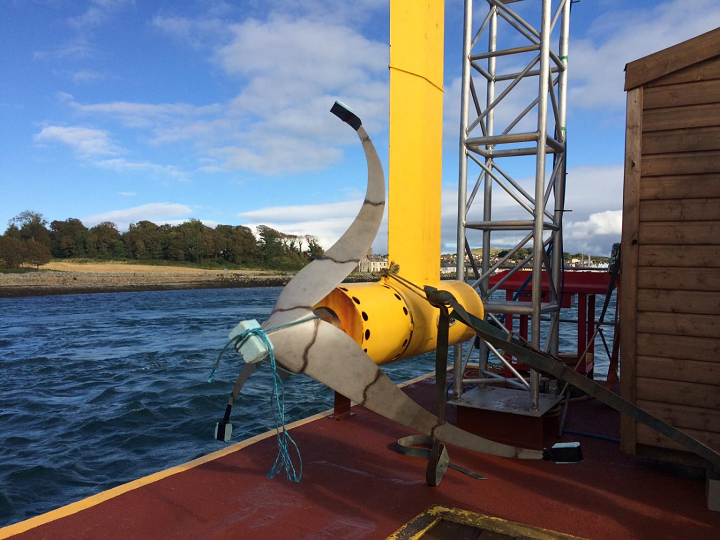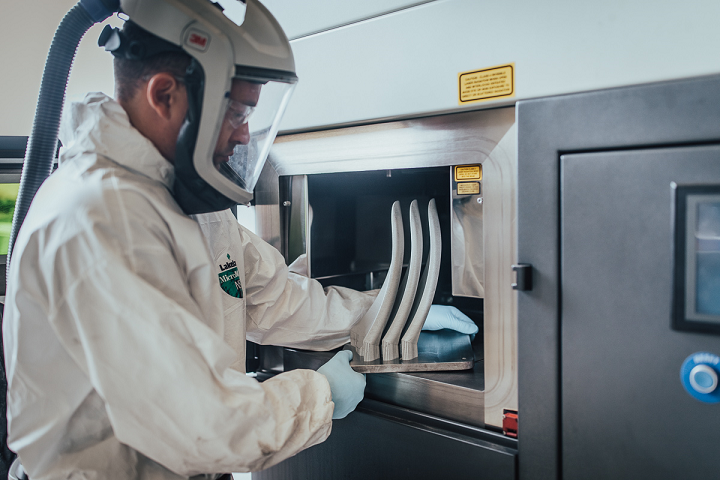Canada-based industrial engineering and design firm Biome Renewables, founded five years ago in Ontario, is on a mission to optimize the power of nature in order to ensure a sustainable future, and focuses specifically on wind turbines. According to the website, its PowerCone ocean turbine retrofit, inspired by the maple seed and the Kingfisher bird, increases annual energy production up to 13% by channeling wind onto the blades in order to address root leakage, which is a big airflow issue that draws power away from the blades. Recently, global engineering technologies company Renishaw and the Nova Scotia Community College (NSCC) partnered up to make two parts for the PowerCone ocean turbine using Renishaw’s metal additive manufacturing expertise.
“Additive manufacturing allowed us to produce the final parts in two months, which would be unthinkable using traditional methods. The ocean turbine project was not only a great opportunity for us to work with one of our many Canadian customers, it was a chance for us to see how metal AM can improve the efficiency of renewable sources,” Mark Kirby, Additive Manufacturing Business Manager at Renishaw Canada, stated in a press release. “Tidal turbine energy is one of many growing renewable energy markets and it was really exciting to be involved in a project like this. While people often think of metal AM as an expensive venture, the technology allowed Biome to reduce the cost of building the turbine by 80 per cent. We look forward to working on more projects like this and seeing how other companies benefit from metal AM.”
Biome Renewables had decided to move into tidal wave energy, and reached out to NSCC for help creating a prototype due to its ocean-related technology and tidal wave energy expertise, as well as its engineering research facility, which has been used to build prototypes for multiple industries. However, the college typically worked with plastic 3D printing, and something stronger and more heavy duty was required for an ocean environment. The PowerCone turbine needed to be able to cope with strong tidal forces, stay standing in the wake of debris impact, and withstand corrosion and major loads, or it could be lost to the deep, polluting the test site and slowing the project.
NSCC determined that a stainless steel PowerCone, featuring non-traditional designs, would be best, as it could then possibly avoid cavitation, which is turbine damage caused by rapid pressure changes in liquid. The college asked Renishaw for help due to its expertise in additive manufacturing, which has been used to fabricate components for wind turbines in the past.
“From a technical standpoint, Renishaw’s team synched really well with ours. We did not have a big skillset in AM, so they were the missing piece to the puzzle and together we had all the components for a successful project,” said Ryan Church, Founder and CEO at Biome Renewables.
“The project was a great opportunity for us to adapt our expertise. AM seemed an obvious choice because we could prototype complex designs with ease. The biggest challenge we faced was adapting our CAD designs to both a new environment and manufacturing method in an efficient way. Getting the meshing and lattice right took some work but rapid prototyping helped us make the final product seamless.”
Because of the unique project requirements, the turbine blades had to be lightweight, but not hollow, so they could tolerate a marine environment without being as likely to sustain debris impact. So NSCC and Renishaw thought that an off-the-shelf turbine, retrofitted with a 3D printed PowerCone, would be the best solution. An internal lattice structure was used to reduce the weight but maintain the turbine’s strength, and surface finishing decreased roughness to make the blades more hydrodynamic.
The Renishaw AM250 3D printer was used to make the parts, and print time was divided between the college and Renishaw. The longest build lasted 150 hours, but all the parts were printed within one month. The PowerCone retrofit sits on the turbine’s hub, co-rotating with its rotor and featuring curved propellers to reduce drag and improve efficiency by up to 15%. Due to its large size, each blade of the retrofit was printed separately, and the parts were then welded together.
“I have worked on several hundred builds and manufacturing the PowerCone was one of the more challenging ones. I often get questions from clients asking if AM parts can be welded together and this project proves that it can certainly be done without negatively impacting the product’s efficiency,” Kirby said.
“Speed was the most impressive aspect of this project. Biome Renewables managed to go from their first design to a successful prototype in a time that would be hard to replicate without AM. Effective collaboration and a balance of expertise made the project an absolute pleasure to work on.”
Renishaw, NSCC, and Biome Renewables used these 3D printed parts to build a prototype turbine, which was tested, with the retrofit and propellers, during the second month of the project at Strangford Loch in Northern Ireland. The testing showed that, after the turbine was submerged, the 3D printed modifications did indeed help produce much more power over a range of tidal velocities.
“As a business with extensive experience in wind energy, we saw an opportunity to adapt our technology to a market ripe for innovation, such as tidal energy. The potential has always been there but there is a lack of products that can extract power in any long term and practical fashion. Creating internal structures in the blade as load-bearing elements using composite manufacturing would have taken more work, money and time than it did with AM. We saved months of time and reduced costs by around 80% with this method,” said Church.
“In the future we plan to develop a large-scale PowerCone to function as a full rotor. This makes the most sense as fewer components mean less load, production time and cost. We would welcome another collaboration with Renishaw in the future.”
(Source/Images: Renishaw)
Subscribe to Our Email Newsletter
Stay up-to-date on all the latest news from the 3D printing industry and receive information and offers from third party vendors.
Print Services
Upload your 3D Models and get them printed quickly and efficiently.
You May Also Like
3D Printing News Briefs, June 11, 2025: Sustainability, Automotive Tooling, & More
We’re starting with sustainability news in today’s 3D Printing News Briefs, as EOS has strengthened its commitment on climate responsibility, and Zestep is making 3D printing filament out of eyewear...
3D Printing 50 Polymer Stand-In Parts for Tokamaks at the PPPL & Elytt Energy
Of all the world’s things, a tokamak is one of the hardest, most complex, expensive and exacting ones to make. These fusion energy devices make plasma, and use magnets to...
3D Printing News Briefs, May 17, 2025: Color-Changing Materials, Humanoid Robot, & More
We’re covering research innovations in today’s 3D Printing News Briefs! First, Penn Engineering developed 3D printed materials that change color under stress, and UC Berkeley researchers created an open source,...
Firehawk Aerospace Partners with JuggerBot 3D, Gets $1.25M from AFWERX for 3D Printed Propellants
Texas-based Firehawk Aerospace, an advanced energetic materials firm that works with aerospace and defense applications, announced a strategic partnership with JuggerBot 3D, an Ohio-based large-format 3D printer manufacturer. Together, the...





































